逻辑回归分类器实现情感识别
任务描述
识别推文中的情感是积极的还是消极的。
给定一个推文: I am happy because I am learning NLP
现在,任务目标就是判断上面的推文是积极的情感(positive sentiment)还是消极的情感(nagetive sentiment)。
给定一个训练集,训练集中包含推文和其对应的标签(label),标签取值为1(代表positive)和0(代表negative)。

任务数据集
NLTK语料库中的tweet数据集。
目录
- 一、数据预处理
- 二、逻辑回归分类器
- 三、特征提取
- 四、训练模型
- 五、测试所写逻辑回归分类器
一、数据预处理
1.1 用向量表示文本(represent a text as a vector)
为了用向量来表示文本,首先需要创建一个词汇表(vocabulary),根据词汇表把文本(text)编码为数组(数组里面是数字)。
在该任务中,遍历数据集所有的推文,将所有的推文用到的全部词汇整理为词汇表(不含重复的词语)。
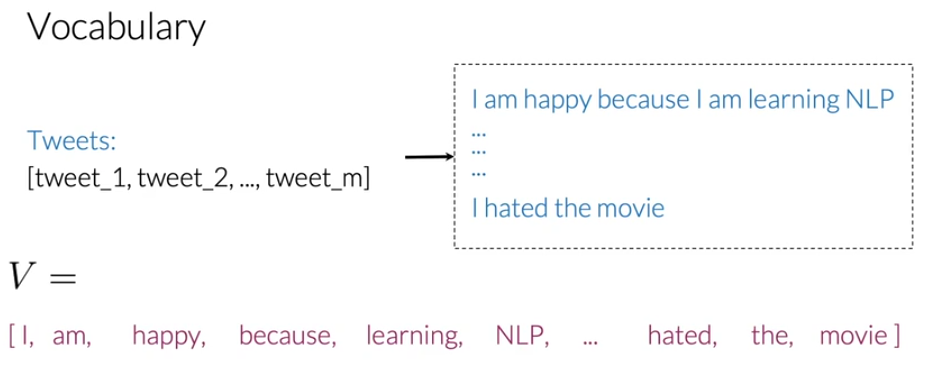
根据上述词汇表,进行推文的特征提取(feature extraction): 
其中,1代表对应词汇表处的单词出现,0代表词汇没有出现。I am happy because I am learning NLP就被表示为[1,1,1,1,1,1,0,0,0,...,0,0,0],特征长度为V(词汇表的大小),其中一共有 6 个1(就算I和am出现两次,但是只用1和0来表示词(word)是否出现,而不看出现的次数)和 V-6 个0。这种表示方式拥有相对较少的非零值,大部分都是0,所以被称为稀疏表示(sparse representation)。
对于上述表示方式,逻辑回归分类器需要学习n个参数(n为词汇表的大小)。如果任务涉及的词汇表十分长,就会导致训练时间很长,同样参数越多的话也会让预测的时间变很长。
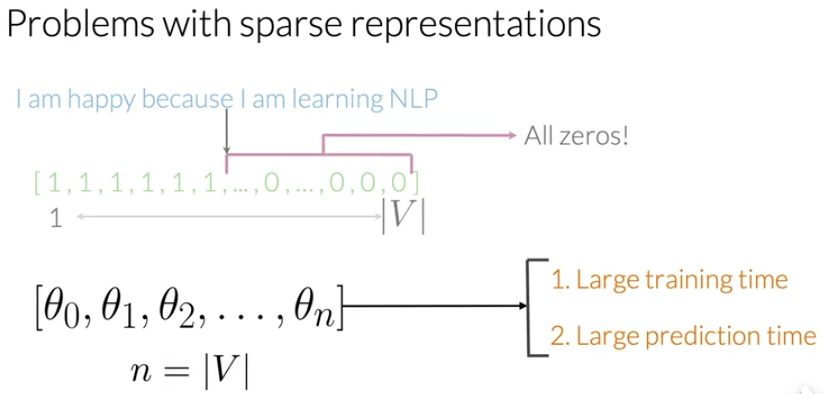
解决方式之一就是利用词(word)在不同类(标签)中出现的次数(count)——frequency作为逻辑回归分类器的特征。举例如下:假设语料库(数据集)为4条推文的集合,而且得出了它对应的词汇表:
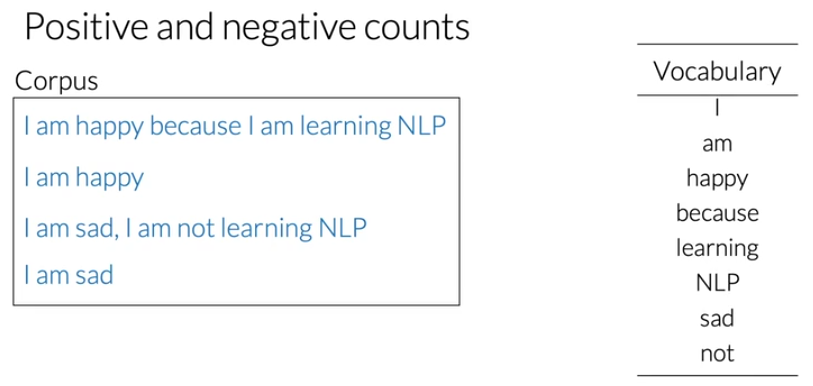
对于数据集中标签为positive的数据(推文),计算其出现的词汇的positive frequency: 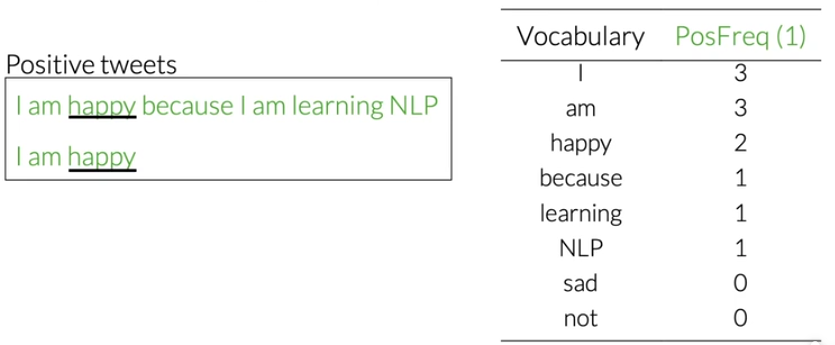
对于数据集中标签为negative的数据(推文),计算其中出现的词汇的negative frequency: 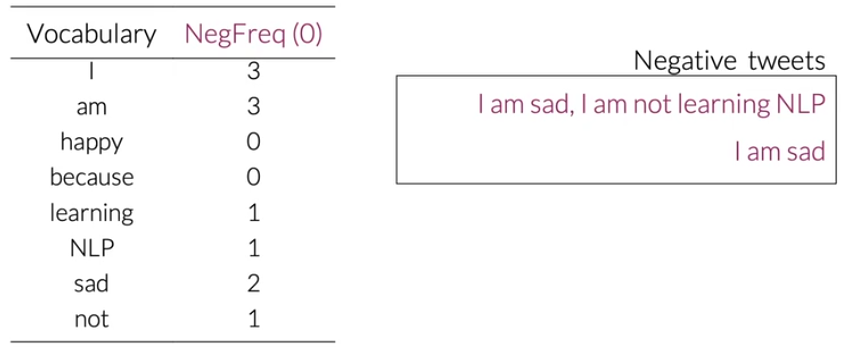
最终得不同类别得词频为: 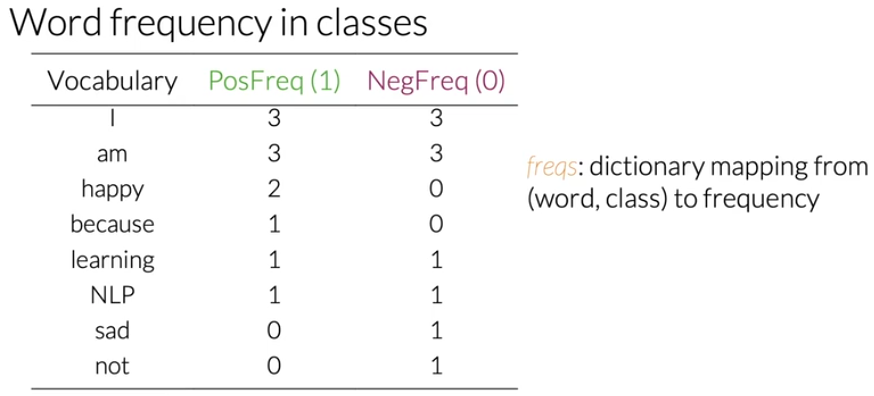
上述词频表的数据结构为字典(dictionary)freqs,将(word, class)映射到了frequency。
现在利用频率字典提取特征。
将任意一条推文(数据) \(X_m\) 表示为一个3维向量,而不是V维向量,如下:
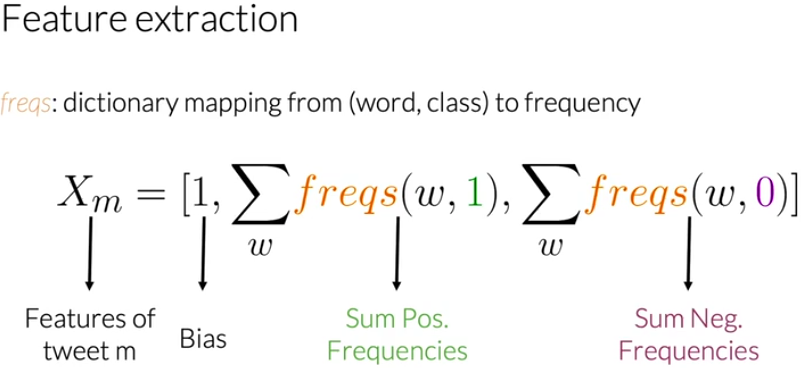
其中,特征向量的第一维是Bias(偏差),第二维是所有词语的positive frequency,第三维是所有词语的negative frequency。举个例子来说: 对于 I am sad, I am not learning NLP ,所有word的positive frequency之和为8: 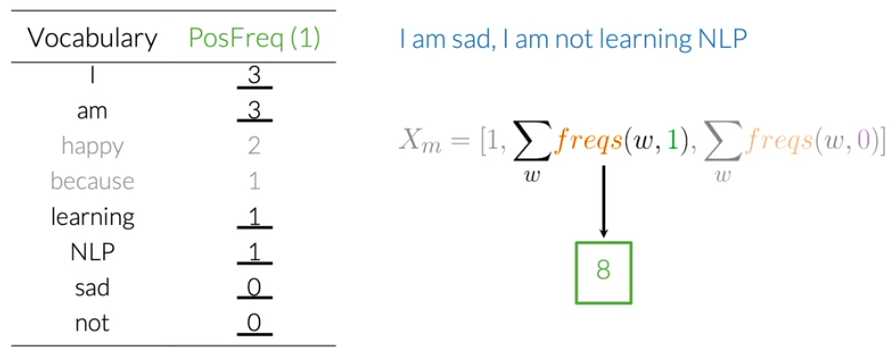 所有word的
所有word的negative frequency之和为: 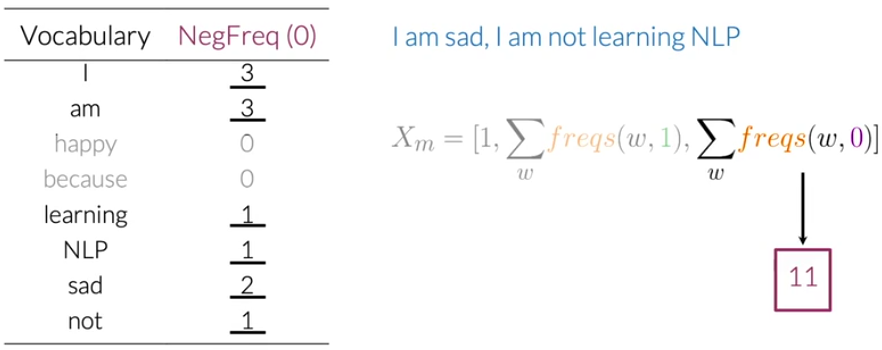
所以,对于推文 I am sad, I am not learning NLP ,它的特征向量为 \(X_m\)为: \[
X_m = [1, 8, 11]
\]
1.2 预处理文本
上面学习了如何根据文本构造逻辑回归的特征,那么这里开始看如何对文本进行预处理。
1 stop words 和 punctuation(标点)
在提取特征前,需要去除stop words,因为stop words通常是没有意义的词语,例如下图中的stop words表,这只是其中很小的一部分(对当前例子来说完全足够)。有时候文本中的punctuation(标点)对任务没有影响,这时就可以根据punctuation表来去除标点。


去除stop words和punctuation后的文本还有可能包含句柄或url,对于情感识别任务,句柄或url没有影响,所以可以去除。

如果某任务中标点符号具有重要信息或者价值,就不用去除标点符号。
2 Stemming(词干提取) 和 lowercasing(小写化)
词干提取(stemming)可以减少统计同一词语的不同形式,词汇量能够大大减少。小写化所有词能够统一词语。

经过上述处理最后得到的推文为:[tun, great, ai, model]。
1.3 代码
导入包
1 | import nltk |
下载NLTK里的推文数据集和stopwords
1 | # nltk.download('twitter_samples') |
准备数据
twitter_samples包含5000条积极推文和5000条消极推文。(其实有关于tweet有三个数据集)
1 | from nltk.corpus import twitter_samples |
1 | all_positive_tweets = twitter_samples.strings('positive_tweets.json') |
1 | print('training data') |
training data
#FollowFriday @France_Inte @PKuchly57 @Milipol_Paris for being top engaged members in my community this week :)
[1.]
train_y.shape = (8000, 1)
test_y.shape = (2000, 1)预处理数据并创建词频字典
- 预处理推文
1 | from nltk.corpus import stopwords |
- 创建词频字典
1 | ## 创建词频字典的函数 |
1 | freqs = build_freqs(train_x, train_y) |
1 | print('len(freqs)', len(freqs)) |
len(freqs) 11340二、逻辑回归分类器
关于逻辑回归分类器参考我的另一篇博客:传送门
分类函数:sigmoid
- sigmoid方程:
\[ h(z) = \frac{1}{1+\exp^{-z}} \tag{1}\] \[z = \theta_0 x_0 + \theta_1 x_1 + \theta_2 x_2 + ... \theta_N x_N\]
1 | def sigmoid(z): |
损失函数与梯度下降
- 损失函数(全部训练样本的平均损失): \[J(\theta) = -\frac{1}{m} \sum_{i=1}^m y^{(i)}\log (h(z(\theta)^{(i)})) + (1-y^{(i)})\log (1-h(z(\theta)^{(i)}))\tag{5} \] 其中,m是训练样本的数量。
- 梯度下降 关于梯度下降法,见博客 损失方程\(J\)关于权重参数中的一个\(\theta_j\)的梯度为: \[\nabla_{\theta_j}J(\theta) = \frac{1}{m} \sum_{i=1}^m(h^{(i)}-y^{(i)})x_j \tag{5}\] 其中,i是样本数的索引,j是权重参数的索引。 一般地有: \[\nabla J(\theta) = \frac{1}{m} \times \left( \mathbf{x}^T \cdot \left( \mathbf{h-y} \right) \right)\] 那么,参数更新的公式即为: \[\mathbf{\theta} = \mathbf{\theta} - \frac{\alpha}{m} \times \left( \mathbf{x}^T \cdot \left( \mathbf{h-y} \right) \right)\]
1 | ## 梯度更新函数 |
1 | # Check the function |
J1 [[0.6709497]]
The cost after training is 0.67094970.
The resulting vector of weights is [4.1e-07, 0.00035658, 7.309e-05]三、特征提取
这里提取推文中的两个特征:
- 一个特征是积极词的数量(标签为积极的推文中出现的词的词频);
- 另外一个特征是消极词的数量(标签为消极的推文中出现的词的词频)。
1 | ## 特征提取函数 |
测试一下特征提取的函数:
1 | tmp = extract_features(train_x[0], freqs) |
[[1.00e+00 3.02e+03 6.10e+01]]四、训练模型
- 将所有样本的特征向量组合为矩阵
X - 进行梯度下降
1 | X = np.zeros((len(train_x), 3)) |
J1 [[0.1309]]
训练后的损失为 0.13089999889658352.
训练后的权重向量为[[ 2.78105442e-07]
[ 1.08727164e-03]
[-9.69515169e-04]].五、测试所写逻辑回归分类器
预测一个推文是积极的还是消极的:
- 处理推文,提取特征
- 将特征输入到已经学习好权重参数的模型进行预测 \[y_{pred} = sigmoid(\mathbf{x} \cdot \theta)\]
1 | def predict_tweet(tweet, freqs, theta): |
1 | def sentiment(x): |
1 | for tweet in ['I am happy', 'I am very pleasent', 'I am bad', |
I am happy-->0.5393185864852428-->Good
I am very pleasent-->0.5000000695263604-->Good
I am bad-->0.4907181319136419-->Bad
this movie should have been great.-->0.5332393560274574-->Good
awful-->0.4932727475531824-->Bad
It's wonderful-->0.5048857705293124-->Good算出分类准确度:
1 | def test_lr(test_x, test_y, freqs, theta): |
1 | tmp_accuracy = test_lr(test_x, test_y, freqs, theta) |
逻辑回归分类器模型的准确度为=0.9945